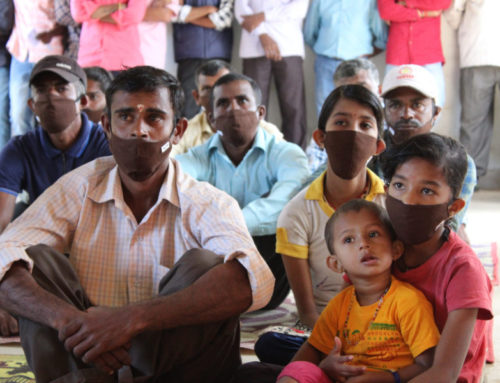Authors: Priyadarshini D. and Dr. Krithi K. Karanth
With the onset of rains, the landscape around the usually dry Chamarajanagar district and the relatively leafy Kodagu district burst into vibrant colours. With fields of banana, coconut, tobacco, marigold, sunflower, cotton, rice, and a variety of cereals, pulses and vegetables, the landscape defies homogeneity. Many of these agricultural lands closely border the two tiger reserves of Bandipur and Nagarahole in the south Indian state of Karnataka, India. Both reserves hold high densities of endangered wildlife such as tigers, leopards and elephants. Many farms lie separated from the forest only by a thin fence, fladry or often poorly maintained trenches. Traversing this landscape and the buffer areas of the parks which remain open to motorists, one is treated to a variety of animal life like wild elephants, dholes, deer, and wild pigs. Such sightings, thrilling to a passer-by, are far more common to local families around these parks who occasionally sight a tiger or leopard too.

Several farms use fladry as a mitigation strategy. However, conflict continues to persist. Effective mitigation strategies are indispensable for managing human-wildlife conflict.
Research conducted by Dr. Krithi Karanth and others on Bandipur and Nagarahole, in addition to three other reserves in the Western Ghats (Karanth et al, 2013; Biological Conservation), noted the density of human and livestock population in the areas adjoining these two parks: 443 people/kilometre square and 337 heads/kilometre square. The continuing survival of large carnivores and herbivores in India despite such conflict is commonly attributed to high levels of tolerance exhibited by people, due to religious or cultural beliefs and practices. But as people and wildlife increasingly encroach into each other’s spaces, interactions between them only intensify, inevitably leading to conflict resulting in losses and increased hostility towards wildlife – ultimately posing a significant challenge to conservation. In order to achieve our conservation goals, it is imperative to find effective strategies which mitigate conflict, losses, and help foster tolerance and coexistence with wildlife.
India reported a total of 78,656 conflict incidents from 18 states in the year 2012-13 – the year for which complete data is available – of which incidents of livestock depredation constituted around 20%. For all these incidents, India paid a total compensation of around $5.3 million. Around 1,269 cases of livestock depredation occurred in the state of Karnataka alone, with a compensation of around $64,213 being paid out to affected families. Compensation for economic costs associated with human-wildlife conflict is employed as a short term, post-hoc policy measure in India to mitigate the consequences of conflict and help foster tolerance for wildlife. Karnataka is one of the 26 states in India that compensates loss caused due to livestock depredation.

Repeated loss of livestock to big cats leads to reduced tolerance for these endangered and iconic species.
Families living around parks and reserves also employ a variety of mitigation measures to help address conflict, such as early warning systems, and protective measures such as fences, fladry, and ditches. Around Bandipur and Nagarahole, it is common to see fences and machans (structure erected on a tree to keep watch) in fields, and long stretches of railway fencing and elephant protection trenches dug by the Forest Department – the latter, sometimes, high up on mountainside resembling great big gashes. It is also common to see livestock tethered inside sheds made of thatch and logs. It was from one such shed that Mubarak lost several of his sheep. He is a sharecropper in the village of Bankahalli, falling within the Hediyala range of Bandipur. The shed is attached to the back wall of his small house. Farmland, adjacent to his shed, provides ample cover for leopard during the rainy season. In a year, six or seven animals would “get wasted” – as he puts it. One instance of livestock predation had very nearly turned into a face to face encounter with a leopard. He had stepped out of his home to investigate noises coming from his shed at the very instant a leopard leapt out of the shed with his sheep. A concrete structure stands in place of his old thatch shed now. He has not lost a single sheep in the past two years since the concrete shed replaced his old one, he confirms.

Traditional livestock sheds are made of logs or thatch which do not provide effective protection to cattle.
Mubarak is the first family for whom Wild Seve – a project jointly implemented by the Centre for Wildlife Studies – has helped build a predator proof livestock shed. In addition to helping obtain compensation for losses from conflict with wildlife, Wild Seve has also begun assisting families with repeated livestock predation incidents to construct livestock sheds. Wild Seve provides the design for the shed and extends partial financial support. The families’ provide funds themselves or leverage local government schemes for the remainder.
So far, Wild Seve has assisted in building 55 livestock sheds. Post construction, none of the assisted families have reported any incident of livestock predation. Built for the most vulnerable families i.e., those experiencing repeat incidents of conflict, these sheds are meant to serve as models for others with livestock. The hope is that they will also invest in alternative mitigation measures that are more effective in protecting their livestock than the traditional sheds. While originally conceived to enable access to government mandated compensation, Wild Seve has evolved to also offer effective solutions which are focused on preventing such losses in the first place.
If you wish to help our program Wild Seve, kindly DONATE HERE.
Additional Reading:
Karanth, K. K., Gopalaswamy, A. M., Prasad, P. K., Dasgupta, S., 2013. Patterns of human-wildlife conflicts and compensation: Insights from Western Ghats protected areas. Biological Conservation
Karanth, K. K., Kudalkar, S., 2017. History, Location and Species Matter: Insights for human-wildlife conflict mitigation from 5000 households in India. Human Dimension of Wildlife
Karanth, K. K., Gupta, S., Vanamamalai, A., 2018. Compensation payments, procedures and policies towards human-wildlife conflict management: Insights from India. Biological Conservation
Karanth, K. K., Vanamamalai, A., 2020. Wild Seve: A Novel Conservation Intervention to Monitor and Address Human-Wildlife Conflict. Frontiers in Ecology and Evolution







